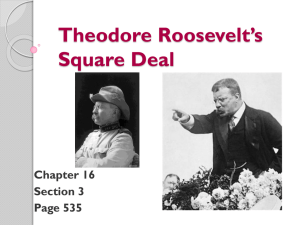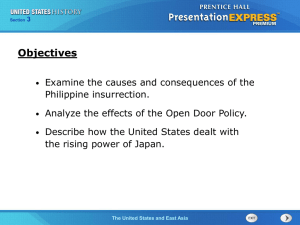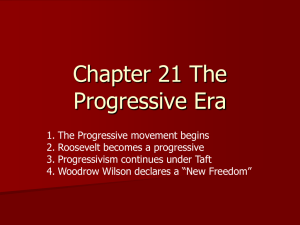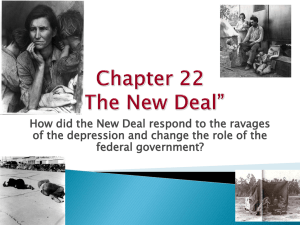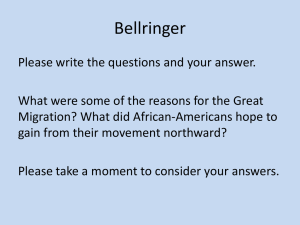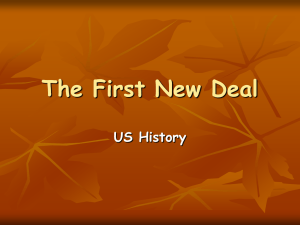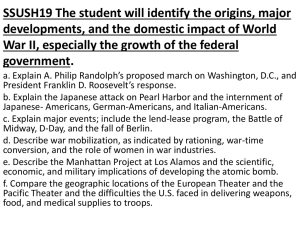Roosevelt and the New Deal Power Point
advertisement
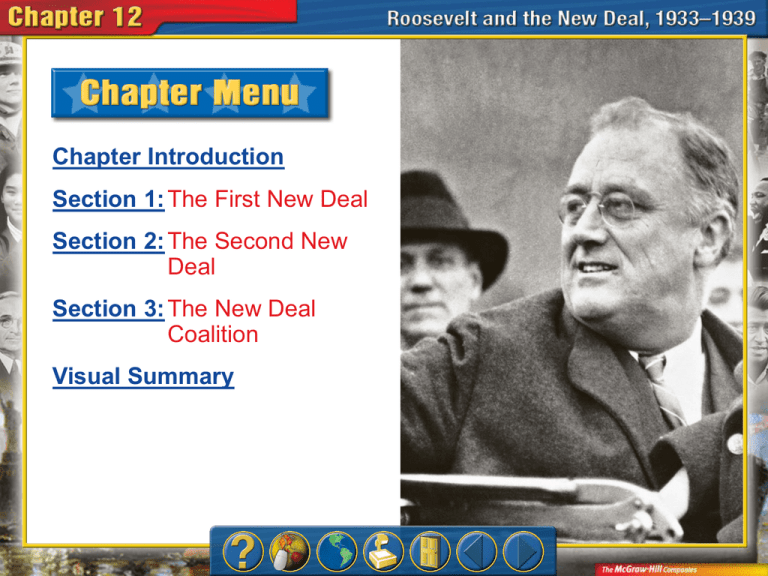
Chapter Introduction Section 1: The First New Deal Section 2: The Second New Deal Section 3: The New Deal Coalition Visual Summary Can Government Fix the Economy? During the 1930s, New Deal programs increased government regulation of banking, industry, and farming; gave greater rights to workers; and provided government aid to the unemployed and senior citizens. • What kind of problems do you think government can solve? • What difficulties can result when the government tries to regulate the economy? The First New Deal In what areas did the New Deal attempt to make major economic improvements? The Second New Deal How did the Second New Deal assist unions, the elderly, and the unemployed? The New Deal Coalition What was the legacy of the New Deal? Roosevelt’s Rise to Power Franklin D. Roosevelt was governor of New York when he was elected president in 1932, promising a New Deal for the American people. Roosevelt’s Rise to Power (cont.) • After losing the 1920 election as the Democratic vice presidential candidate, Franklin Delano Roosevelt temporarily withdrew from politics. – The next year he caught polio, but refused to give in. – In 1928, Roosevelt ran for governor of New York. – He won the election and oversaw the creation of the first state relief agency to aid the unemployed. Roosevelt’s Rise to Power (cont.) • Roosevelt’s popularity in New York paved the way for his presidential nomination in 1932. – His policies for ending the Depression became known as the New Deal. – On election day, Roosevelt beat Herbert Hoover in a landslide. The Hundred Days Upon taking office, FDR launched the New Deal by sending 15 major pieces of legislation to Congress. The Hundred Days (cont.) • Although Roosevelt won the presidency in November 1932, the country’s unemployed and homeless had to endure another winter as they waited for his inauguration. – Some of the bank runs occurred because people feared that Roosevelt would abandon the gold standard and reduce the value of the dollar in order to fight the Depression. – In 38 states, governors declared bank holidays to save the remaining banks. The Hundred Days (cont.) • By the day of Roosevelt’s inauguration, most of the nation’s banks were closed. – One in four workers was unemployed. • Between March 9 and June 16, 1933—which came to be called the Hundred Days— Congress passed 15 major acts to resolve the economic crisis. – These programs made up what would later be called the First New Deal. The Hundred Days (cont.) • To generate new ideas and programs, Roosevelt deliberately chose advisers who disagreed with each other. – One group during the early years of his administration supported the “New Nationalism” of Theodore Roosevelt. – A second group wanted government planners to run key parts of the economy. – A third group supported the “New Freedom” of Woodrow Wilson. Banks and Debt Relief President Roosevelt took steps to strengthen banks and the stock market and to help farmers and homeowners keep their property. Banks and Debt Relief (cont.) • Roosevelt knew the first thing he had to do was restore confidence in the banking system. – The House of Representatives unanimously passed the Emergency Banking Relief Act after only 38 minutes of debate. – On March 12, sixty million people listened to the first of many of Roosevelt’s “fireside chats.” Banks and Debt Relief (cont.) – He assured people that their money was safe in banks, and the next day, deposits far outweighed withdrawals. • Roosevelt listened to his advisers and supported the Securities Act of 1933 and the Glass-Steagall Banking Act. – Congress also created the Securities and Exchange Commission (SEC) to regulate the stock market and prevent fraud. The First Hundred Days Banks and Debt Relief (cont.) – The Glass-Steagall Act created the Federal Deposit Insurance Corporation (FDIC) to provide government insurance for bank deposits up to a certain amount. • To help homeowners make their mortgage payments, Roosevelt asked Congress to establish the Home Owners’ Loan Corporation (HOLC). The First Hundred Days Banks and Debt Relief (cont.) – Congress also authorized the Farm Credit Administration (FCA) to help farmers refinance their mortgages. The First Hundred Days Farms and Industry New Deal legislation tried to raise crop prices and stabilize industry. Farms and Industry (cont.) • To further help the nation’s farmers, Secretary of Agriculture Henry Wallace drafted the Agricultural Adjustment Act. – Administered by the Agricultural Adjustment Administration (AAA), the government paid farmers not to raise certain livestock, not to grow certain crops, and not to produce dairy products. – The plan worked, but did not benefit everyone, especially tenant farmers. The TVA, 1940 Farms and Industry (cont.) • The government turned its attention to manufacturing in June 1933, when Roosevelt and Congress enacted the National Industrial Recovery Act (NIRA). – Under the leadership of Hugh Johnson, the National Recovery Administration (NRA) ran the entire program. – By the time the Supreme Court declared the NRA unconstitutional in 1935, it had already lost much of its political support. The TVA, 1940 Relief Programs Programs such as the CCC, the PWA, and the WPA provided jobs for some unemployed workers. Relief Programs (cont.) • The most highly praised New Deal work relief program was the Civilian Conservation Corps (CCC). – The CCC offered unemployed young men 18 to 25 years old the opportunity to work under the direction of the forestry service planting trees, fighting forest fires, and building reservoirs. Relief Programs (cont.) • Congress also established the Federal Emergency Relief Administration (FERA), led by Harry Hopkins. – In June 1933 Congress authorized another relief agency, the Public Works Administration (PWA) which put civilians to work on government-funded construction projects. Relief Programs (cont.) • Roosevelt authorized Hopkins to set up the Civil Works Administration (CWA), since FERA and the PWA weren’t reducing unemployment significantly. – The agency did provide jobs through the winter, but Roosevelt insisted that it be shut down the following spring due to the large amount of money the agency spent. Relief Programs (cont.) • Perhaps the most important result of the first New Deal was a noticeable change in the spirit of the American people. – Roosevelt’s actions had inspired hope and restored Americans’ faith in their nation. Which of the following did the Civil Works Administration build or improve? A. Airports D. Schools B E. All of the above A 0% 0% E C. Playgrounds D B. Roads C A. A B. B C. C D. D 0% E.0% E0% Launching the Second New Deal By 1935, the New Deal faced political and legal challenges, as well as growing concern that it was not ending the Depression. Launching the Second New Deal (cont.) • Although New Deal programs had created more than 2 million new jobs, more than 10 million workers remained unemployed, and the nation’s total income was about half of what it had been in 1929. • Hostility toward Roosevelt came from both the political right and the left. • To pay for his programs, Roosevelt had started deficit spending, and many business leaders became greatly alarmed at the government’s growing deficit. Launching the Second New Deal (cont.) • In August 1934 business leaders and antiNew Deal politicians from both parties joined together to create the American Liberty League. • Three people who challenged Roosevelt were: – Huey Long – Father Coughlin – Francis Townsend Launching the Second New Deal (cont.) • In 1935 Roosevelt launched a series of programs now known as the Second New Deal. – Among these new programs was the Works Progress Administration (WPA), headed by Harry Hopkins. – The WPA’s most controversial program was Federal Number One, a program for artists, musicians, theater people, and writers. Launching the Second New Deal (cont.) • In May 1935, in Schechter Poultry Company v. United States, the Supreme Court unanimously struck down the authority of the NRA. – Roosevelt feared that the Court would strike down the rest of the New Deal and told Congress that they could not go home until they passed his new bills. Reforms for Workers and the Elderly Roosevelt asked Congress to pass the Wagner Act and Social Security to build support among workers and older Americans. Reforms for Workers and the Elderly (cont.) • In July 1935 Congress passed the National Labor Relations Act (also called the Wagner Act), which guaranteed workers the right to organize unions and to bargain collectively. – Congress also set up the National Labor Relations Board (NLRB). – The Wagner Act set up a process called binding arbitration. Reforms for Workers and the Elderly (cont.) • The Committee for Industrial Organization (CIO) set out to organize unions that included all workers, skilled and unskilled, in a particular industry. – Union organizers used new tactics, such as the sit-down strike. – By using a sit-down strike, the United Auto Workers (UAW) became one of the most powerful unions in the U.S. Union Membership, 1933–1940 Reforms for Workers and the Elderly (cont.) • In 1938 the CIO changed its name to the Congress of Industrial Organizations and became a federation of industrial unions. • After passing the Wagner Act, Congress began work on one of America’s most important pieces of legislation—the Social Security Act. – Although Social Security helped many people, it initially left out many of the neediest—farm and domestic workers. Reforms for Workers and the Elderly (cont.) – Social Security did establish the principle that the federal government should be responsible for those who, through no fault of their own, were unable to work. Roosevelt’s Second Term Roosevelt was easily reelected, but the New Deal lost momentum during his second term due to his court-packing plan and a new recession. Roosevelt’s Second Term (cont.) • Since the Civil War, African Americans had been reliable Republican voters. – However, in the 1930s, they became just one part of a new Democratic coalition that included farmers, industrial workers, African Americans, new immigrants, ethnic minorities, women, progressives, and intellectuals. Roosevelt’s Second Term (cont.) • African Americans and women made some modest gains during the New Deal. – The president appointed several African Americans to positions in his administration, where they informally became known as the Black Cabinet. – FDR appointed the first woman to a cabinet post, Secretary of Labor Frances Perkins, and appointed many other women to lower-level posts. Roosevelt’s Second Term (cont.) • In the election of 1936 the Republicans nominated Alfred Landon. – Roosevelt swept to victory in one of the largest landslides in American history • Although many people supported the New Deal, the Supreme Court saw things differently. – In March 1937 Roosevelt sent Congress a bill to increase the number of justices. Roosevelt’s Second Term (cont.) – The court-packing plan, as the press called it, was FDR’s first serious political mistake. – The Senate quietly killed the bill without bringing it to a vote. – Roosevelt still achieved his goal of changing the Court’s view of the New Deal. Roosevelt’s Second Term (cont.) • In 1937 Roosevelt’s reputation again suffered when unemployment suddenly surged. – The recession of 1937 led to a debate inside Roosevelt’s administration. – Treasury Secretary Henry Morgenthau favored balancing the budget and cutting spending. Roosevelt’s Second Term (cont.) • Harry Hopkins, head of the WPA, and Harold Ickes, head of the PWA, pushed for more government spending using a new theory called Keynesianism to support their arguments. – Keynesianism was based on the theories of an influential British economist named John Maynard Keynes. Roosevelt’s Second Term (cont.) • According to Keynesian economics, FDR had done the wrong thing when he cut back programs in 1937. – Finally, in the spring of 1938, with no recovery in sight, Roosevelt asked Congress for money for the PWA, the WPA, and other programs. First Lady Eleanor Roosevelt demonstrated strong sympathies toward which group? A. Native Americans B. Unskilled workers C. African Americans D. Immigrants 0% A A. B. C. 0% D. B A B C 0% D C 0% D The New Deal Ends The New Deal expanded federal power over the economy and established a social safety net. The New Deal Ends (cont.) • One of the president’s goals for his second term was to provide better housing for the nation’s poor. – He responded with the National Housing Act, establishing the United States Housing Authority. • He also sought to help the nation’s tenant farmers. What New Deal Programs Still Exist Today? The New Deal Ends (cont.) – Congress created the Farm Security Administration to give loans to tenants so they could purchase farms. • The Fair Labor Standards Act was the last major piece of New Deal legislation. – By 1939, the New Deal era had come to an end. What New Deal Programs Still Exist Today? The New Deal Ends (cont.) • The New Deal had only limited success in ending the Depression. – As a whole, the New Deal tended to balance competing economic interests. • In taking on a mediating role, the New Deal established what some have called the broker state. – This role has continued under the administrations of both parties ever since. What New Deal Programs Still Exist Today? The New Deal Ends (cont.) • FDR’s programs also succeeded in creating a safety net for Americans. – By the end of the 1930s, many Americans felt that the government had a duty to maintain this safety net, even though doing so required a larger, more expensive federal government. What New Deal Programs Still Exist Today? Banking and Finances • Emergency Banking Relief Act regulated banks. • Federal Deposit Insurance Corporation insured bank deposits. • Farm Credit Administration refinanced farm mortgages. • Home Owners’ Loan Corporation financed homeowners’ mortgages. Agriculture and Industry • Agricultural Adjustment Administration paid farmers to limit surplus production. • National Industrial Recovery Act limited industrial production and set prices. • National Labor Relations Act gave workers the right to organize unions and bargain collectively. • Tennessee Valley Authority financed rural electrification and helped develop the economy of a seven-state region. Work and Relief • Civilian Conservation Corps created forestry jobs for young men. • Federal Emergency Relief Administration funded city and state relief programs. • Public Works Administration created work programs to build public projects, such as roads, bridges, and schools. Social “Safety Net” • Social Security Act provided – income for senior citizens, handicapped, and unemployed – monthly retirement benefit for people over 65 Chapter Transparencies Menu Why It Matters Cause-and-Effect Transparency Unit Time Line Transparency Select a transparency to view. polio abbreviated form of poliomyelitis, an acute infectious disease affecting the skeletal muscles, often resulting in permanent disability and deformity gold standard a monetary standard in which one ounce of gold equals a set number of dollars bank holiday closing of banks during the Great Depression to avoid bank runs fireside chats radio broadcasts made by FDR to the American people to explain his initiatives apparent appearing to be fact as far as can be understood ideology a system of thought that is held by an individual, group, or culture fundamental being of central importance deficit spending government practice of spending borrowed money rather than raising taxes, usually in an attempt to boost the economy binding arbitration process whereby a neutral party hears arguments from two opposing sides and makes a decision that both must accept sit-down strike method of boycotting work by sitting down at work and refusing to leave the establishment benefit to be useful or profitable finance to provide money for a project thereby by that means court-packing the act of changing the political balance of power in a nation’s judiciary system whereby a national leader, such as the American president, appoints judges who will rule in favor of his or her policies broker state role of the government to work out conflicts among competing interest groups safety net something that provides security against misfortune; specifically, government relief programs intended to protect against economic disaster recovery an economic upturn, as after a depression mediate an attempt to resolve conflict between hostile people or groups To use this Presentation Plus! product: Click the Forward button to go to the next slide. Click the Previous button to return to the previous slide. Click the Home button to return to the Chapter Menu. Click the Transparency button from the Chapter Menu, Chapter Introduction, or Visual Summary slides to access the transparencies that are relevant to this chapter. From within a section, click on this button to access the relevant Daily Focus Skills Transparency. Click the Return button in a feature to return to the main presentation. Click the History Online button to access online textbook features. Click the Reference Atlas button to access the Interactive Reference Atlas. Click the Exit button or press the Escape key [Esc] to end the chapter slide show. Click the Help button to access this screen. Links to Presentation Plus! features such as Maps in Motion, Graphs in Motion, Charts in Motion, Concepts in Motion, and figures from your textbook are located at the bottom of relevant screens.
